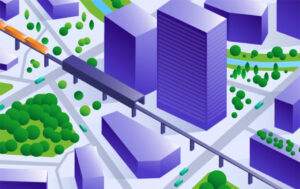Perspective: Cell phone data could help define cities
Cell phone data could be the key to an accurate and timely definition of what a city is, Paolo Santi and colleagues, including Denise Pumain, Emeritus Professor at University Paris I Panthéon-Sorbonne, member of CNRS laboratory Géographie-cités, argue in a Perspective published in the first issue of Nature Cities. They contend that an accurate and global definition of a city is crucial for the successful implementation of legislation and policies, such as the United Nation’s Sustainable Development Goals.
The first cities were likely founded five millennia ago, in and around present-day Iraq, as agricultural surpluses supported growing settlements. Since then, cities have sprung up across the globe. Some have morphed together into metropolitan areas, and many have changed in shape and size. For example, China’s Guangdong–Hong Kong–Macao Greater Bay Area includes nine cities that have converged into an urban ‘megalopolis’ of more than 80 million people, and the US cities of Boston, New York, Philadelphia and Washington D.C. now form a near-continuous urban band.
A recent report from the United Nations Human Settlements Programme (UN-Habitat) recognizes the need for a globally agreed-upon definition of a city. Existing definitions of a city tend to focus on population density or building placement as seen in satellite imagery. However, neither of these variables focus on flows of people, like city commuters, and these flows are what knit together today’s morphing cities, linking urban form with urban function. As such, the authors of this Perspective propose criteria for a general definition of a city, including that it be understandable, universal and accessible, as well as usable by the growing urban science community.
The Nature Cities Perspective piece suggest that cell-phone data in the forms of call detail records and GPS can offer researchers insights into what constitutes a city to meet the proposed criteria. The anonymized data can offer spatial and temporal information on people within a given geographic area and can shed light on the daytime or nighttime presence of people. The researchers write that “cell-phone data provide a consistent collection mechanism across the world and are independent of national censuses”.
The research team notes that cell-phone data has limitations. Primarily, cell-phone data is secured by private companies and is protected from outside parties via non-disclosure agreements and privacy regulations. At the same time, the data itself may overrepresent certain populations, such as younger and wealthier users.
However, they conclude that, “this approach would facilitate the replicability of studies and comparisons across different geographies, bringing invaluable benefits to the research community”.
This text is a Nature Cities Perspective piece, not a Nature Cities research paper or article. Perspective pieces are topical, authoritative Op-Eds pertaining to scientific research and its ramifications. The Perspective was peer reviewed.
 Nature Cities
Nature Cities
Nature Cities is a new monthly, online journal launched in January 2024 by the Editing Group Nature. Nature Cities will publish insightful research and opinion about cities and urban issues broadly. All editorial decisions are made by a team of full-time professional editors.
Nature Cities aims to deepen and integrate basic and applied understanding of the nature of cities, including their roles, impacts and influences — past, present and future. The journal will feature cutting-edge research, synthetic reviews and timely news and opinions. By bringing together diverse content and voices, it aims to transcend divides among disciplines, among regions and among researchers, practitioners, policymakers and the public.
Nature Cities will cover the full scope of research, opinion, and ideas relevant to understanding cities broadly. This includes coverage that is global, regional and local, and that features diverse voices and viewpoints, including those with practical and policy relevance. It will feature both quantitative and qualitative research from across relevant natural and social sciences, engineering, professional disciplines, and humanities.


